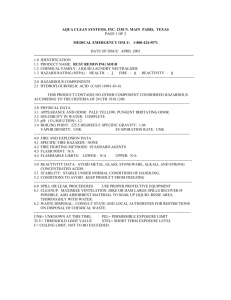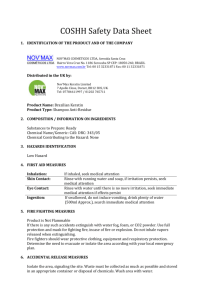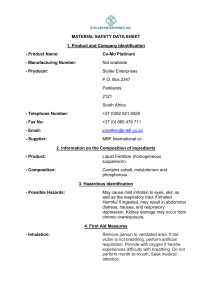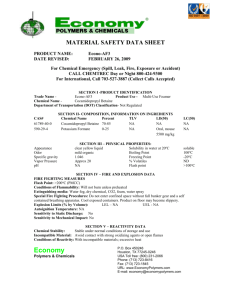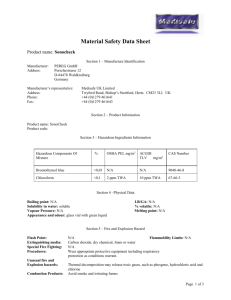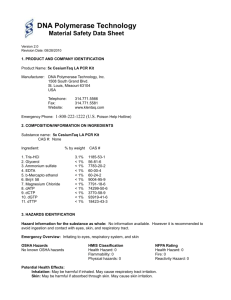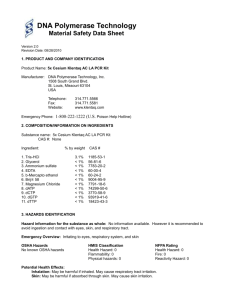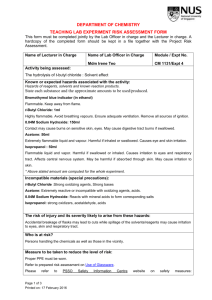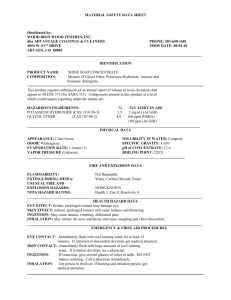DEPARTMENT OF CHEMISTRY TEACHING LAB EXPERIMENT
advertisement
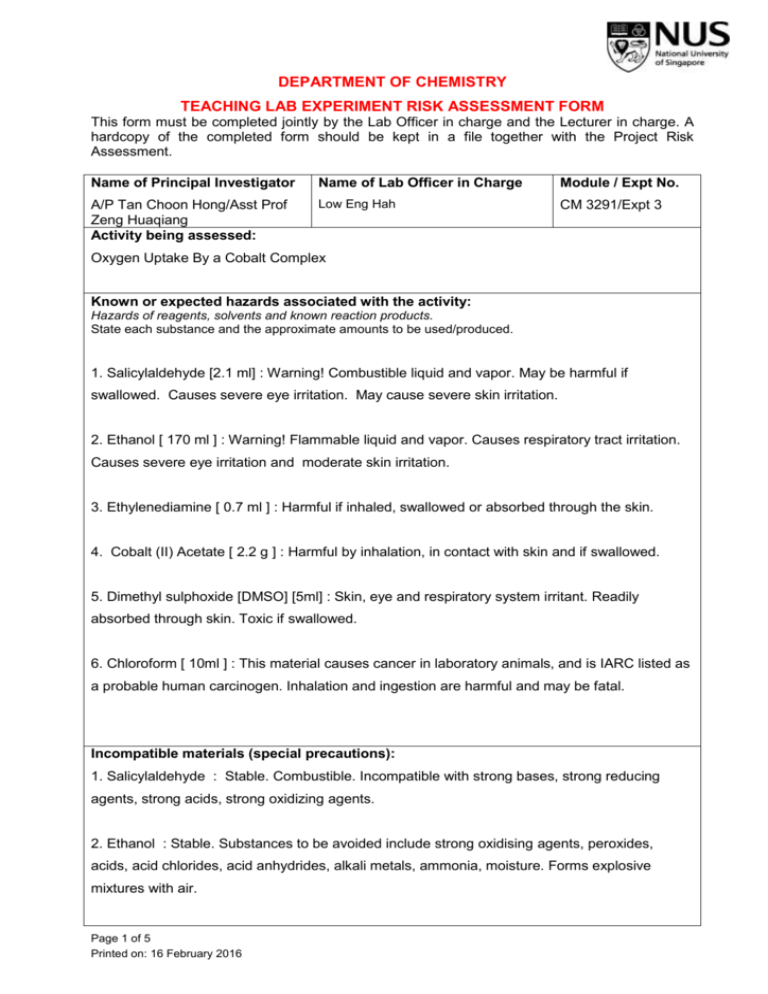
DEPARTMENT OF CHEMISTRY TEACHING LAB EXPERIMENT RISK ASSESSMENT FORM This form must be completed jointly by the Lab Officer in charge and the Lecturer in charge. A hardcopy of the completed form should be kept in a file together with the Project Risk Assessment. Name of Principal Investigator Name of Lab Officer in Charge Module / Expt No. A/P Tan Choon Hong/Asst Prof Zeng Huaqiang Activity being assessed: Low Eng Hah CM 3291/Expt 3 Oxygen Uptake By a Cobalt Complex Known or expected hazards associated with the activity: Hazards of reagents, solvents and known reaction products. State each substance and the approximate amounts to be used/produced. 1. Salicylaldehyde [2.1 ml] : Warning! Combustible liquid and vapor. May be harmful if swallowed. Causes severe eye irritation. May cause severe skin irritation. 2. Ethanol [ 170 ml ] : Warning! Flammable liquid and vapor. Causes respiratory tract irritation. Causes severe eye irritation and moderate skin irritation. 3. Ethylenediamine [ 0.7 ml ] : Harmful if inhaled, swallowed or absorbed through the skin. 4. Cobalt (II) Acetate [ 2.2 g ] : Harmful by inhalation, in contact with skin and if swallowed. 5. Dimethyl sulphoxide [DMSO] [5ml] : Skin, eye and respiratory system irritant. Readily absorbed through skin. Toxic if swallowed. 6. Chloroform [ 10ml ] : This material causes cancer in laboratory animals, and is IARC listed as a probable human carcinogen. Inhalation and ingestion are harmful and may be fatal. Incompatible materials (special precautions): 1. Salicylaldehyde : Stable. Combustible. Incompatible with strong bases, strong reducing agents, strong acids, strong oxidizing agents. 2. Ethanol : Stable. Substances to be avoided include strong oxidising agents, peroxides, acids, acid chlorides, acid anhydrides, alkali metals, ammonia, moisture. Forms explosive mixtures with air. Page 1 of 5 Printed on: 16 February 2016 3. Ethylenediamine : Incompatible with aldehydes, phsophorus halides, organic halides, oxidizing agents, strong acids, copper, its alloys and its salts. Hygroscopic. 4. Cobalt (II) Acetate : Stable. Incompatibilities: moisture and heat. Hazardous combustion or decomposition products Toxic fumes of : carbon monoxide, carbon dioxide ,cobalt/cobalt oxides. 5. Dimethyl sulphoxide [DMSO] : Incompatible with a very wide range of materials, including acid chlorides, strong acids, strong oxidizing agents, strong reducing agents, phosphorus halides, moisture, copper wool + trichloroacetic acid. 6. Chloroform : May decompose on exposure to light. Incompatible with a wide variety of materials, including peroxy compounds, alkali amides, strong bases, alkali metals, magnesium, aluminium, strong oxidizing agents. Exposure to alcohol may increase toxic effects. The risk of injury and its severity likely to arise from these hazards: Salicylaldehyde: May be harmful if swallowed. Causes severe eye irritation. May cause severe skin irritation. Ethanol : Causes skin and eye irritation. Ingestion can cause nausea, vomitting and inebriation; chronic use can cause serious liver damage. Ethylenediamine : Harmful if inhaled, swallowed or absorbed through the skin. May cause allergic reactions. May cause burns to the skin. Very destructive of mucous membranes Cobalt (II) Acetate : May cause sensitization by skin contact. Irritating to eyes, respiratory system and skin. DMSO [dimethyl sulphoxide] : Readily absorbed through skin. Chloroform: It is carcinogen. Inhalation and ingestion are harmful and may be fatal. Who is at risk? The students who do the experiments. May have the effect on all occupants. Page 2 of 5 Printed on: 16 February 2016 Measure to be taken to reduce the level of risk: 1. Wear safety goggles 2. Wear disposable hand gloves 3. Wear lab coat 4. carry out experiments in the fume hoods 5. Safety shower and eye wash 6. first aid kits 7. fire extinguishers 8. spillage kits. Training prerequisites: Advise students on the hazards of reagents used. Refer to prepared risk assessments on use of glassware, use of fume hoods and use of standard electrical equipment. Use of Glassware Use of Standard Electrical Equipment http://www.chemistry.nus.edu.sg/PSSO/Safety/Risk/Solvent.htm Level of risk remaining: Low Emergency action if : Spill: 1. Salicylaldehyde : Eliminate ignition sources. Prevent from entering drains. Use solvent absorbent. Take off immediately all contaminated clothing. To clean the floor and all objects contaminated by this material, use water and detergent. 2. Ethanol : Eliminate ignition sources. Use solvent absorbent Take off immediately all contaminated clothing. 3. Ethylenediamine : Eliminate ignition sources. Prevent from entering drains. Use solvent absorbent. Take off immediately all contaminated clothing. 4. Cobalt (II) Acetate : Avoid dust. Sweep to safe place. Use water for cleaning. 5. DMSO : Absorb with solvent absorbent. Take off immediately all contaminated clothing. 6. Chloroform : Prevent from entering drains. Absorb with solvent absorbent. Fire: Page 3 of 5 Printed on: 16 February 2016 1. Salicylaldehyde : Use dry powder fire extinguisher [provided in the lab.]Dry chemical, . 2. Ethanol : Keep containers cool. Water spray or Use powder fire extinguisher [provided in the lab.] 3. Ethylenediamine : Keep containers cool. Water spray or Use powder fire extinguisher [provided in the lab.] 4. Cobalt (II) Acetate : Water spray. 5. DMSO : Water spray. 6. Chloroform : Water spray. Is the experiment suitable for out-of-hours operation? Yes No References if any: Signature of Lab Officer in Charge::……………………………………………………………….. Date:………………………… Signature of Lecturer in Charge:………… …………………………………….. Date:… …………………….. Prepared Risks Assessments for standard equipment and operation are with the kind permission of Dr. Ken MacNeil, School of Chemistry, University of Bristol. Page 4 of 5 Printed on: 16 February 2016 Activity being assessed: Note any activity to be used which entail risk (e.g. use of glass vacuum apparatus, high pressures, high voltage, radiation, high temperatures). Give reference to any special protocols to be followed, and if appropriate attach copies to the risk assessment form. State any additional precautions taken to minimise risk. Known or expected hazards associated with the activity: FOR EACH CHEMICAL, read the MSDS and note:a) Particular hazards (e.g. highly toxic, carcinogenic, corrosive, flammable, pyrophoric, explosive, volatile, dust hazard). Note any dangerous combinations of properties (e.g. volatile and toxic). b) Requirements for safe handling (e.g. fume cupboard, inert atmosphere, low temperature). c) How to dispose of residuals Dispose to drain, with water dilution Neutralise, then to drain with suitable dilution To flammable liquid waste receptacle To non-flammable liquid waste receptacle Keep for recovery/recycling Keep for special disposal later (e.g. heavy metals) Double bag and dispose to dry waste Special procedure (specify) Incompatible materials (special precautions) Note any dangerously incompatible materials and hazards arising from contact of any reagents and substances used with common materials such as paper, benches, hoses, etc. Measures to be taken to reduce the level of risk Include hazards of previously unknown products. Location of work – laboratory, open bench, fume cupboard Level of risk remaining: Likelihood and consequences of any accident or unforeseen events whilst carrying out the activity. When this has been done, choose the appropriate procedure:a) Close supervision and/or attendance of trained first-aider needed. b) Specific approval of supervisor needed. c) Training is needed prior-to or during the operations specified. d) Training is complete and only general laboratory competence required. e) No risk perceived. Emergency action: a) Any special requirements to deal with accidental spillage or leakage. b) What to do in the event of accidental exposure (skin contact, inhalation, etc.). Page 5 of 5 Printed on: 16 February 2016
